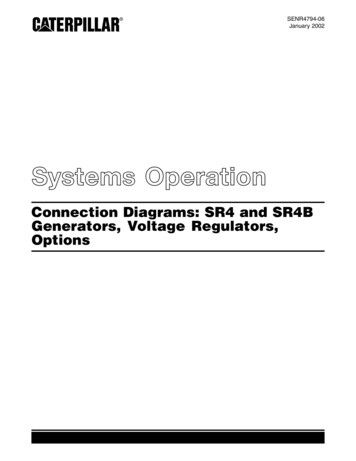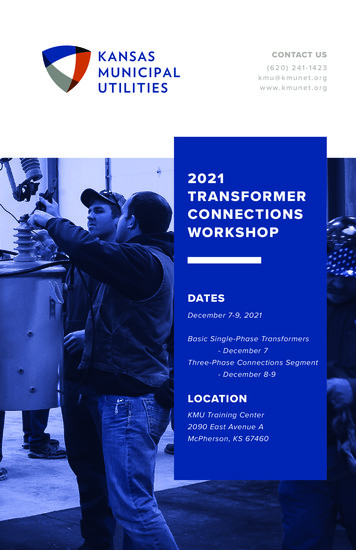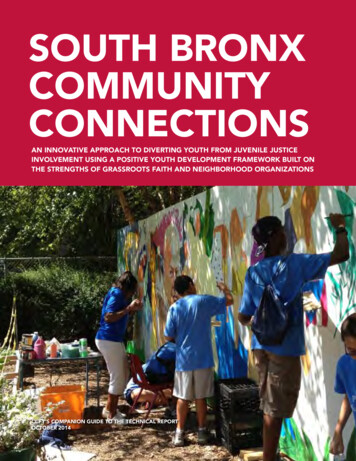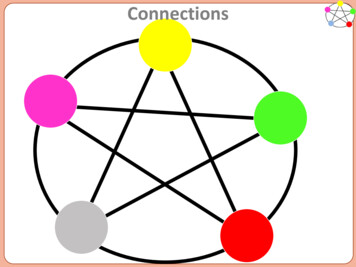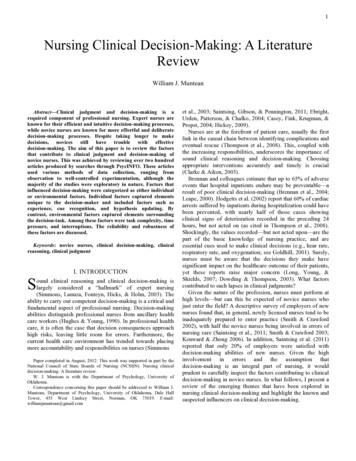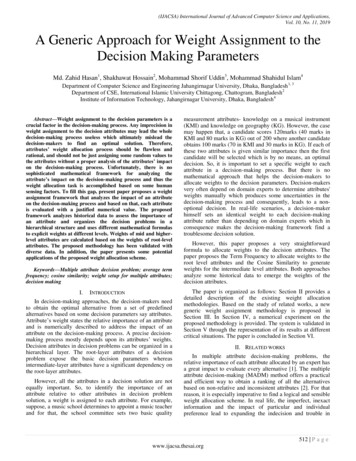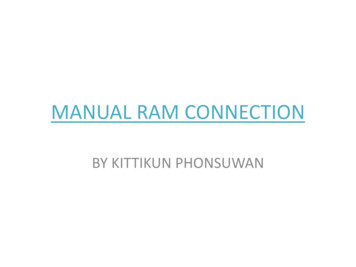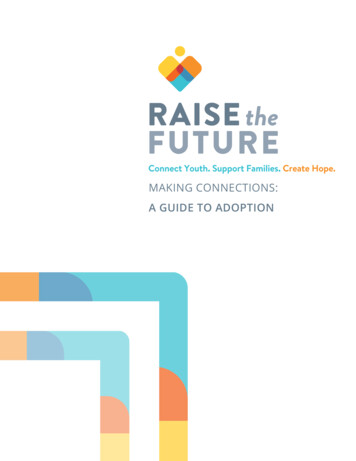
Transcription
MAKING CONNECTIONS:A GUIDE TO ADOPTION
Welcome,Thank you for contacting us about adoption.Raise the Future believes every young person deserves to go through life knowing they have acaring adult by their side. Every day, we show up for kids in foster care by listening to their needsand introducing them to adults they can rely on. We then surround those connections with support,so they grow into meaningful, lasting relationships that help youth heal from the past.The youth we serve are generally: Over the age of nine Members of a sibling group Youth of color Youth with physical, cognitive, and/or emotional delaysAll of the youth with whom we work have experienced the trauma of being removed from theirfamilies and placed in foster care. Many have also experienced other traumatic events in their lives.Raise the Future works with state and local child welfare systems to connect these youth with adultswho can provide them with non-judgmental, unconditional love and commitment to help themthrive throughout their lifetimes.If you are new to the adoption process, we encourage you to do the following: Contact your public human services agency and private adoption agencies in your area toask about their adoption programs Engage with local adoptive parent groups, including social media groups Learn about adoption and caring for youth who have experienced trauma Explore our lending library for titles on adoption, trauma, and grief and loss Attend our informational monthly webinars: Adoption Options and Foster to AdoptThe following information will help you get started on your journey towards adoption. Please beaware that guidelines, policies, and procedures differ between states and even sometimesbetween counties within the same state. Use this information as a general guide, and let us know ifyou have questions or need more information. Although Raise the Future is not a licensed childplacement or adoption agency and does not have custody of any children, we are here to help youlearn about your options for growing your family and about how you can make a difference in thelife of a child.We wish you well in your adoption process.-Raise the Future Staff
Adoption StepsOpening your heart to a child in need of connection is a selfless and loving act. This valuableinformation can serve as a guide as you consider expanding your family and learn about youroptions. The adoption process varies from state to state, so please feel free to call us at1-800-451-5246 or email us at kids@raisethefuture.org for more information. You can also find thename and contact information for your state’s Adoption Program Manager on the National FosterCare & Adoption Directory Search at www.childwelfare.gov/nfcad.1. Decide What Kind of Adoption Is the Best Fit for Your Family. First, you will want to decidethe age of child you are interested in adopting and through which pathway.Adoption from Foster Care: Typically, children legally available for adoption are over age nine.Younger children who become legally available for adoption while in foster care are commonlyadopted by relatives or their current foster family. If you wish to adopt a younger child from fostercare, you will first need to consider becoming a foster parent. Foster parents must support theprimary goal of reunification for children and their families. Learn more about foster care at https://www.raisethefuture.org/foster-care.Infant Adoption: Generally, this type of adoption is facilitated through a private adoption agency oran adoption attorney. Birth parents typically choose an agency to facilitate the adoption of theirinfant and play a key role in selecting the adoptive family.International Adoption: Children and youth up to age 16 years of age may be availablefor adoption from other countries. Adoption regulations vary widely by country, and the process canbe lengthy. Finalizing an adoption of a child as an infant is not common in international adoption.Check out the U.S. Department of State’s Intercountry Adoption webpage at untry-Adoption.html to learn more.2. Select an Agency. Interview agencies to find the right fit for you. See ‘Choosing an Adoption Agency’ sectionbelow for a list of questions to ask. Attend orientation meetings offered by public and private agencies in your area. County and state departments of social services seek adoptive homes for children who havebeen in foster care due to abuse and/or neglect and cannot return safely to their families. To adopt a child from abroad, you must work with an agency that is specifically licensed toconduct international adoptions.3. Attend Information Classes. Most public and private agencies require you to attend a series ofclasses to learn about the adoption process and the emotional and behavioral issues that adoptedchildren may experience. In many cases, you must complete these classes before the agency willbegin the family assessment process.109.2020
4. Complete the Family Assessment Process. The family assessment (also called an adoptionstudy or home study) varies by agency and by type of adoption. It should be an educational andself-evaluation process, as well as a way for the agency to assess your strengths, ability to meet achild’s needs related to adoption and trauma, identify any areas of concern or growth, and help youdetermine which child would best fit your home.The family assessment will include some or all of the following: Initial application to adopt Autobiographies writtenby each parent Visits to your home Medical reports from yourphysician Proof of employment/ability to financiallysupport a child Checks for any criminalrecord, including the statechild abuse registry References from friendsand associates Participation in adoptiveparent training classes toprepare you for raising achild likely to have a history of trauma, educational needs, behavioral challenges, emotionalneeds, or who is of a different race, religion, or ethnicity A family picture book or video to present to the birth mother or waiting child, or overseasagency interviews with your social worker that should touch on the following topics: The reasons you want to adoptYour hopes and expectations for your childYour readiness to parentYour family’s values, strengths, and weaknessesYour own historyHow your family handles crises and changesWhere you will get support or professional help if you need it209.2020
5. Child Matching.Once your family assessment is completed and approved, your social workerwillbegin considering your family for a child/ren. After being selected, you will be given extensiveinformation about the child to help you consider whether your family is a good fit for this child. Somesocial workers, from both public and private agencies, may encourage you to be involved inexploring the profiles of waiting children to find possible matches for your family. Always let yoursocial worker know what you are doing to help identify a child. Actions you might want to takeinclude: Look for waiting child features in adoption newsletters, social media posts, newspapers, andmagazines Watch televised features about waiting children (“Wednesday’s Child”) Access websites that feature profiles of waiting children (www.raisethefuture.org, www.adoptuskids.org) Search for online Heart Gallery websites in your state, region, or across the nation Register as a prospective adoptive family with AdoptUSKids (www.adoptuskids.org)6. While You Wait. This is one of the most challenging aspects of the adoption process. Waitinghappens: After the message you send to an agency to ask about adoption (voicemail, email, etc.) While you wait to attend an orientation meeting After you submit your application and before training classes begin Before your home study begins After your home study is approved While you wait for a placement After a child is placed in your homeWaiting can be frustrating, lonely, and disempowering. Although you must make many decisionsthroughout this time (i.e. when is the right time to build our family through adoption? can I handlethis? can we afford it? what age/gender of child do I prefer? should I quit my job? and so on), it mayfeel as if this very important part of your life is not in your own hands.During this period, we encourage you to use the time to learn as much as you can about adoptionand its lifelong impact on the lives of adoptees and adoptive families. Some ideas to considerinclude: View our “While You Wait” training webinar (Part I, Part II, Handouts - https://www.raisethefuture.org/on-demand-learning) Read adoption and trauma-related materials (these can be recommended by our staff) Visit your school district to introduce yourself and learn about the process for registering anew student309.2020
Find local mental health providers, both public and private, who have experience andexpertise working with adoptive families Connect with pre/post-adoptive parent support groups and blogs Identify a pediatrician in your area who you trust and with whom you can talk openly If you plan to adopt from foster care, find a pediatrician who accepts Medicaid Begin to line up your support network of family and friends Consider becoming a respite care provider for other adoptive or foster families; contactyour local department of social services to learn what is needed and how to connect Attend adoption and trauma-related training; we offer many live (https://www.raisethefuture.org/upcoming-classes) and on-demand ) courses Review the materials and information on the Child Welfare Information Gateway (www.childwelfare.gov/topics/adoption/)7. Pre-placement. During this time, you may visit with the birth family of the infant you plan to adopt,you may have several visits of increasing length with the child you are adopting from foster care, oryou may begin making travel plans to bring home the child you plan to adopt internationally. Youragency will help facilitate these visits or plans.8. Placement. Your child finally comes home!9. Post-placement. Your agency, social worker, parent group, and professional counselors can helpyour family during this often challenging time. The social worker will be required to visit with youregularly, provide support and assistance, and make reports to the court to be sure the placement isprogressing well before finalizing the adoption. During this period, your agency will assist you in filinga petition to adopt with the court.10. Finalization. Your social worker will usually go to court with you when you go before a judge tofinalize the adoption and officially welcome the child as a legal member of your family. Most infantadoptions are finalized six months after placement. In many states, adoptions from foster care maybe finalized six months after placement; however, this timeframe can often extend for a year or moreafter placement to give the child and family enough time to adjust and to be sure that the family cansuccessfully meet the child’s needs.11. Post-finalization. Adoption is a lifelong process for the child and the adoptive family. Donot hesitate to contact your agency and social worker for help, support, referrals, and to sharesuccesses. Raise the Future is also here to support you long-term. Visit our Family Support urces).409.2020
“Adoption is a special kind of love that is sharednot by people who are related by blood,but by people who are related by love.”– Seventh-grade student
Choosing an Adoption AgencyWhen you are considering adoption, the wide variety of options can seem overwhelming. You willhave a number of choices to make, so gather as much information as possible.1. Talk with others. Members of adoptive parent groups have firsthand knowledge about adoptionand can offer valuable insight.2. Attend agency orientation meetings.3. Interview public and private agencies. Contact your state’s Adoption Program Manager withinthe Department of Human Services to receive a list of licensed adoption agencies.The following questions may help you determine which agency is best for your family. What types of adoptions does the agency conduct - infant adoptions, adoptions of childrenfrom foster care, adoptions of children from other countries? Agencies that conduct morethan one of these types ofadoption or place children fromAdoptions of waiting children through publicdifferent countries will refer tosocial services agencies are often free. Iftheir different “programs.”fees are charged, you may be eligible forHow many children did thereimbursement for some of those costs whenagency place last year? Howa child from that agency is placed with you.many were placed from thespecific program you areAgency fees for private infant and internationalinterested in?adoptions can range from 10,000 - 50,000.What are the agency’sgeneral requirements about thecharacteristics of theprospective parents they workwith (i.e., age of adoptiveparents, single or nontraditionalfamilies, marital history, lengthof marriage, religious affiliation,fertility restrictions, number ofchildren already in the family)?Do these requirements varydepending on the type ofadoption?How much will it cost tocomplete an adoption? Arethere sliding fee scales? Whenwill payments be required?Request a fee schedule from the adoptionagency you are considering so you know, beforeyou begin, exactly what costs are covered inthe adoption fee and what costs may be addedlater. Examples of typical charges include legalfees, the birth mother’s and/or infant’s medicalexpenses, expenses for travel to visit a waitingchild in another state, or expenses for travel tobring a child home from another ent and adoption assistance/subsidies can be found in the ‘AdoptionAssistance and Other Financial Assistance’section below.609.2020
How long will it take to complete an adoption? Each adoption is unique. However, you canask about the average length of time families wait between applying to adopt and beginningthe family assessment. You can also ask how long you should expect to wait betweencompletion of the assessment and having a child placed in your home. What steps are required in the process? Although each agency’s procedures vary and thereare different requirements for each type of adoption, you can expect to complete some orall the following: Initial interview Application form Adoption preparation classes Family assessment (also called an adoption home study) At what point does the agency notify prospective parents of their approval for placement?Can you see a copy of your family assessment/home study? If you are not approved, canyou find out why? What is the agency’s grievance process? What steps will the agency take to help identify the right child for your family? What can ormust you do to help? Does the agency conduct home studies for families seeking to adopt both in-state and outof-state children? Most public agencies placing children from foster care are primarilyconcerned about placing the children in their custody. As an adoptive family, they see youas a resource for their children. Often, states or counties require you to be a resource fortheir children for at least six months before they will release your home study to anotheragency or state. Most private agencies facilitate adoptions within your state and otherstates. Most private agencies placing newborns will facilitate a match between you and oneof the birth mothers with whom they are working. In an infant adoption, dothe birth parents select theadoptive parents? Are thebirth parents and adoptiveparents able to decide howmuch communication they wantbefore and after the child isplaced? Who determines howopen the adoption will be? Does the agency have a websiteor photos and profiles of waitingchildren (in your state and inother states) that you can view? If adopting from foster care, isadoption assistance availableto help cover the costs of the709.2020
child’s medical or emotional needs? Do not finalize an adoption of a child from foster careuntil you have an adoption assistance agreement in writing from the child’s agency. A factsheet to review can be found here: www.childwelfare.gov/pubPDFs/f subsid.pdf. In an international adoption, once a family accepts a child, how long will it be before thechild can travel to the United States? Is the adopting family required to travel to bring thechild home? How long will one or both parents need to stay in the child’s country of origin? In an international adoption, is the agency or attorney licensed or Hague Accredited toconduct international adoptions? Do they work with foreign agencies that are licensed oraccredited in their own countries? What happens if prospective parents do not feel they can accept the child the agency hasmatched with them? What kind of support services does the agency offer to the adoptive family and birthparents before, during, and after placement of the child? Does the agency offer counselingor support groups? What services are available after the adoption is finalized? What if the adoption does not work out? Will you be considered for another child? Is it possible to talk with families who have adopted through the agency or through thespecific program you are interested in? Most agencies will provide names of familieswho were happy with their adoption experience. Most states maintain complaint filesfor licensed agencies in the licensing department at their department of human servicesoffice. Again, parent support groups are often an excellent resource for evaluations of localagencies. Is the agency a non-profit or a for-profit organization? How does the agency allocate itsmoney?Choose your agency based on their programs and your feelings of comfort and trust in them. Afteryour choice is made, get to know your agency. Subscribe to their newsletter mailing list. Get to knowthe staff and, in turn, they will feel increasingly more familiar with you.809.2020
Adoption Assistance and Other Financial AssistanceThere are several sources of financial help available to those who adopt children from foster care.Financial help is more limited for other types of adoption. The following is a list of financial assistanceresources.Title IV-E Adoption Assistance Program: Most, though not all, children in the foster care systemare eligible for benefits under this program. Other government assistance (i.e. state-fundedadoption assistance) may be available for children in the foster care system who do not qualify forTitle IV-E benefits.For an adoptive family to be eligible for reimbursement, the state must have determined that: The child should not or cannot be returned to the home of the birth parents. There exists a specific factor or condition—such as age, membership in a sibling group, orthe presence of physical, mental, or emotional challenges—that makes it reasonable toconclude that the child cannot be placed with adoptive parents without providing adoptionassistance.There are several rules which govern adoption assistance/subsidy agreements: The amount of the subsidy is to be determined by the adopting parents and the stateagency. The agreement must indicate the nature and amount of expenses to be paid. There must be no incomeeligibility requirement for theadopting parents to qualify forpayment. Reimbursement will not be paidif expenses are reimbursedthrough another source, suchas adoption benefits you receivefrom your employer. The agreement must be signedprior to the final decree ofadoption. Obtaining adoptionassistance after finalizationis very difficult, though it ispossible to request assistanceretroactively. Parents canappeal a negative decision.909.2020
Adoption assistance is a resource to help adoptive parents meet the demands of caring forthe special needs of a child adopted from foster care. This agreement may or may notinclude the following components: a monthly cash stipend, Medicaid, or access to othersupportive services. Most financial assistance is based on the needs of the adopted child, regardless of thefamily’s financial resources, though those resources will be considered when determiningthe amount of assistance to be provided. Many children waiting in foster care are eligible for financial assistance. Assistance may be short-term or may last until the adopted child reaches maturity (age 18or 21, depending on the state’s requirements). Adoption assistance can come from local, state, or federal funds. An adopting family must apply for adoption assistance through their county or privateagency social worker. A one-time reimbursement of non-recurring expenses related to the adoption of children infoster care who meet the state’s eligibility criteria may be available. In cases where siblingsare placed and adopted, either separately or together, each child is treated as an individualand reimbursement of non-recurring expenses is allowable for each child, up to the state’smaximum amount. Qualifying expenses may include costs to have the family assessment(home study) completed, costs for undergoing physical health and psychologicalexaminations, court fees, and attorney fees. Reasonable costs associated withtransportation, food, and lodging for the child and/or the adoptive parents, when necessaryto complete the placement or adoption process, may also be included.Additional Sources of Financial Assistance for Adoptive Families:Federal tax credit. Since 2003, families who adopted a child with special needs from foster carecan claim a federal adoption tax credit. Children who receive adoption assistance/subsidy benefitsare considered children with special needs.*For adoptions finalized in 2020, there is a federal adoption tax credit of up to 14,300 per child.The 2020 adoption tax credit is NOT refundable, which means taxpayers can only use the creditif they have a federal income tax liability. The credit applies one time for each adopted child andshould be claimed when taxpayers file taxes for 2020. For more information about the adoption taxcredit, visit the IRS website at www.irs.gov/taxtopics/tc607.Employee benefits programs. Check with your employer to see what benefits they offer foradoptive families.Special subsidies for adoptive families in the military. Explore the National Military FamilyAssociation’s website at www.militaryfamily.org/info-resources/adoption/ to learn about the benefitsand supports available to military families who adopt.1009.2020
Adoption loans and grants. Various foundations establish grants to help defray the cost ofadoption. You can also talk to your banker or credit union about loan options. Visit the NationalAdoption Foundation’s website at www.fundyouradoption.org for information about their grantsand loans.Lastly, a good place to read and learn about the costs of all types of adoption and resourcesavailable to support these expenses is Planning for Adoption: Knowing the Costs andResources, which can be found at www.childwelfare.gov/pubPDFs/s costs.pdf.Raise the Future encourages you to ask your social worker about available subsidies/assistancewhen adopting any child with special physical, mental, medical, or emotional needs.1109.2020
“I’m so glad you found me.I had something missing.”—Malik
Terms to KnowAdoption Assistance: Financial or medical assistance can be given on a one-time or ongoing basisto an adoptive parent on behalf of an adopted child. This subsidy may be provided through federal,state, county, and/or local resources. (See Title IV-E.)Adoption Exchanges: Organizations designed to help identify prospective adoptive parents bysharing information about children for whom an adoptive family is needed. Exchanges also provideadvocacy, training, information, and referrals for adoption agencies and adoptive families, as well aspost-adoption services.Adoption Home Study: The process of educating prospective adoptive families about adoption,ensuring that their home would be a safe and appropriate place for a child, and determining whatchild characteristics would best fit with the family. Home studies are usually done by licensed socialworkers affiliated with a public or private adoption agency. Independent social workers, adoptionattorneys, and other adoption facilitators may also provide this service. A home study is requiredbefore a child can be placed for adoption.Adoption Services: Any activity/procedure designed to facilitate the entire legal process of adoptionincluding intake, pre-placement activities and planning, adoptive placement of the child, postplacement activities, and post-legalization (or post-finalization) services.Birth Parents: Also called biological parents. This is the preferred term for the parents who gavebirth to a child.Closed Adoption: An adoption in which identifying information about the birth parents andadoptive parents is considered confidential and is not made available. Records containing thisconfidential information are usually sealed because of state law and/or court order.Designated Adoption: The birth family selects a specific family to adopt their child either directlyor with the aid of a liaison or adoption facilitator. In some states, birth parent counseling is required,and the adopting family must complete an adoption home study.Disruption: When a child who was placed for adoption is removed from the prospective adoptivehome and returned to foster care before the adoption is finalized. Reasons for disruptions vary butare generally the result of some incompatibility between the child and the family. In most cases, thechild is eventually placed with another adoptive family.Finalization: The legal act that establishes a family connection between the adopting personand the adopted person. Usually occurring in a courtroom setting, this act grants rights andresponsibilities to the adoptive parent and child equal to those rights and responsibilities granted tofamilies created by birth. Finalization can take place as early as six months after the child is placed inthe adoptive home, but it often does not occur until a year or longer after placement.1309.2020
Foster-Adopt: This type of placement is used when the child has a concurrent permanency plangoal of reunification and adoption. The foster parent, who is fully certified as both a foster andadoptive parent, agrees to work with the birth family toward reunification and is committed toadopting the child if reunification efforts fail.Foster Parent(s): Adult(s) who provides a temporary home and everyday nurturing and supportfor children who have been removed from their homes. The individual(s) may be a relative ornonrelative and is required to be licensed to provide care for children in foster care and to supportreunification of the child with their birth family.Group Home: A large foster home licensed to provide care for several children. Some group homesfunction as family homes with parents who are always available; others have staff members whowork at different times along with the group home parents.Guardian Ad-Litem (GAL): A person appointed by the court to represent a child in all courthearings that concern the child. A child’s GAL is usually an attorney.Hold: Term used to inform families inquiring about children waiting to be adopted that the child’sagency is not interested in receiving inquiries about the child at this time. Reasons for the “hold”vary. The term is also used in reference to prospective families who may be registered with anadoption exchange.Independent Adoption: An adoption that takes place without the involvement of established publicor private agencies. This type of adoption may also be called a private adoption and is generallyfacilitated by an attorney.Interstate Compact: (ICPC) - Interstate Compact on the Placement of Children: This is anagreement between states to coordinate the placement of children for adoption across state lines.The compact guarantees that each state’s adoption laws and procedures are met, and the child’splacement is properly managed and finalized.Matched: This is the term used when an adoptive family has been selected for a waiting child. Inmost cases, the family is learning more about the child, but the child has not yet moved into theadoptive home.Open Adoption: An adoption in which there is some interaction between the birth family, adoptivefamily, and the adopted child. Generally, the adoptive family and the birth family agree to a level andstyle of communication that is comfortable for both parties and is in the best interest of the child.Communication may be by phone, written correspondence, or personal contact. In a semi-openadoption, contact may be maintained through an intermediary—usually the adoption agency.Placement: A child may have had numerous out-of-home placements after a social services agencyhas determined that the child is not safe in their current home. The agency may place a child withrelatives, in emergency shelters, foster homes, group homes, residential treatment centers, orpsychiatric hospitals. This term is also used to refer to the day when a child moves into an adoptivehome (i.e., placement day).1409.2020
Post-Legal Adoption Services: Services provided by an adoption agency to the adopted person,the adoptive parents, and/or the birth parents after an adoption has been legally finalized. Theseservices may include counseling, support groups, and respite care.Post-Placement: The period between the date a child moves into the adoptive family home andfinalization of the adoption. A variety of post-placement activities may be offered by an adoptionagency to an adoptive family, such as counseling, referrals, support, and visits by a social worker.Purchase of Service: A contract between two agencies whereby the agency having custody of thechild pays the agency workin
Infant Adoption: Generally, this type of adoption is facilitated through a private adoption agency or an adoption attorney. Birth parents typically choose an agency to facilitate the adoption of their infant and play a key role in selecting the adoptive family. International Adoption: Children and youth up to age 16 years of age may be available
